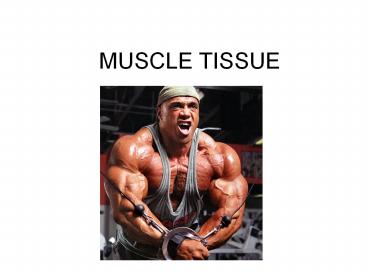MUSCLE TISSUE - PowerPoint PPT Presentation
1 / 17
Title:
MUSCLE TISSUE
Description:
skeletal. smooth. cardiac. Additional common names. Striated voluntary m. Visceral muscle m. Non-striated involuntary m. Striated involuntary m. Shape of Cell – PowerPoint PPT presentation
Number of Views:186
Avg rating:3.0/5.0
Title: MUSCLE TISSUE
1
MUSCLE TISSUE
2
Muscle Tissue
- If it contracts, it's muscle
- Muscle tissue is categorized on the basis of a
functional property the ability of its cells to
contract. - consists of the contractile protein fibrils actin
and myosin. Muscle is responsible for movement of
the body and changes in the size and shape of
internal organs. - Muscle cells are generally referred to as muscle
fibres. - Muscle fibres are typically arranged in parallel
arrays allowing them to work together effectively
3
The three types of muscle
- Three types of muscle tissue can be identified
histologically - skeletal muscle (striated muscle, voluntary),
- cardiac muscle
- smooth muscle (non-striated muscle, involuntary).
4
Skeletal muscle
- Skeletal muscle constitutes the muscle that is
attached to the skeleton and controls motor
movements and posture.
5
Skeletal Muscle
- Skeletal muscle fibres (cells) are multinucleated
- They are filled with longitudinally arrayed
subunits called myofibrils. - The myofibrils are made up of the myofilaments
myosin (thick filaments) and actin (thin
filaments). - The striations reflect the arrangement of actin
and myosin filaments and support structures. - The individual contractile units are
called sarcomeres.
6
Skeletal Muscle Summary
- Summary Skeletal muscle fibres bear obvious
striations, have many peripherally located
nuclei, are of the same thickness throughout
their length and do not branch.
7
Skeletal Muscle
8
Skeletal Muscle
9
Cardiac Muscle
- Cardiac muscle is the type of muscle found in the
heart - Cardiac muscle is intrinsically contractile but
is regulated by autonomic (unconscious) and
hormonal stimuli.
10
Cardiac Muscle Summary
- Striations are present (actin and myosin)
- Greater number of mitochondria present
- Cardiac muscle cells have only one or two nuclei,
which are centrally located. - Cardiac muscle cells are joined to one another in
a linear array. The boundary between two cells
abutting one another is called an intercalated
disc. - Cardiac muscle fibres are branched
11
Cardiac Muscle
12
Cardiac Muscle
13
Smooth Muscle
- Smooth muscle is the intrinsic muscle of the
internal organs, iris of the eye and blood
vessels. - Like cardiac muscle, smooth muscle fibres are
intrinsically contractile but responsive to
autonomic and hormonal stimuli. They are
specialized for slow, prolonged contraction.
14
Smooth Muscle
- Smooth muscle fibres are generally arranged in
bundles or sheets (no striations) - A single nucleus is located in the central part
of the fibre. - Fibres do not branch.
- Smooth muscle fibres lie over one another in a
staggered fashion - Fusiform Shape with tapered ends
15
Smooth Muscle
16
Musclel Tissue Summary
17
Muscle Tissue Summary































